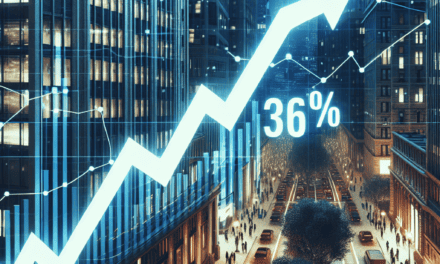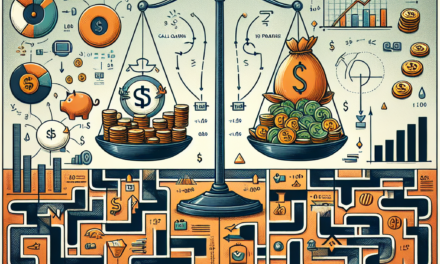“From Setback to Silver: Finding Fortune in Unexpected Places”
Introduction
In the world of investing, not every trade goes as planned, and sometimes, even the most well-researched strategies can lead to unexpected outcomes. Such was the case with my recent venture into the tumultuous waters of Trump-related trades. Despite the initial optimism and the allure of potential gains, the trade ultimately flopped, leaving me to reassess my approach and learn from the experience. However, amidst the disappointment, I discovered a silver lining that not only softened the blow but also provided valuable insights for future endeavors. This unexpected benefit has reshaped my perspective on risk, reward, and the unpredictable nature of the market, proving that even in failure, there can be a path to growth and resilience.
Understanding Market Volatility: Lessons Learned from a Failed Trade
Navigating the financial markets is often a journey filled with unexpected turns and lessons. My recent experience with a trade involving Trump-related stocks serves as a testament to the unpredictable nature of market volatility. While the trade did not yield the anticipated profits, it provided invaluable insights into the complexities of market dynamics and the importance of strategic planning.
Initially, the trade seemed promising. The political landscape, influenced by former President Donald Trump, had created a unique set of opportunities. Stocks associated with his policies and public statements often experienced significant fluctuations, presenting potential for substantial gains. However, as with any investment, the potential for reward was accompanied by considerable risk. Despite thorough research and analysis, the trade did not perform as expected, leading to a financial loss.
This outcome, while disappointing, underscored the inherent volatility of the market. It highlighted the fact that even well-researched trades can be derailed by unforeseen events or shifts in investor sentiment. The experience reinforced the necessity of maintaining a diversified portfolio to mitigate risk. By spreading investments across various sectors and asset classes, the impact of a single underperforming trade can be minimized, preserving overall financial stability.
Moreover, this experience emphasized the importance of emotional discipline in trading. The initial excitement of a promising trade can quickly turn to anxiety when the market moves unfavorably. It is crucial to remain calm and avoid making impulsive decisions based on short-term market movements. Developing a well-defined trading plan and adhering to it, regardless of market conditions, can help maintain focus and prevent emotional reactions from dictating investment choices.
In addition to these lessons, the failed trade offered a silver lining in the form of enhanced market understanding. Analyzing the factors that contributed to the trade’s underperformance provided deeper insights into market behavior. It became evident that political events, while influential, are just one of many factors that can impact stock prices. Economic indicators, global events, and investor sentiment all play significant roles in shaping market trends. Recognizing this complexity is essential for making informed investment decisions.
Furthermore, the experience highlighted the value of continuous learning and adaptation in the world of trading. Markets are dynamic, and strategies that succeed in one environment may not be effective in another. Staying informed about market developments and being willing to adjust strategies in response to changing conditions is crucial for long-term success. This adaptability not only enhances trading skills but also builds resilience in the face of market volatility.
In conclusion, while the Trump trade did not yield the desired financial outcome, it provided a wealth of knowledge and experience. Understanding market volatility is a critical aspect of successful trading, and each experience, whether profitable or not, contributes to a trader’s growth. By embracing the lessons learned from failed trades and applying them to future endeavors, investors can navigate the complexities of the financial markets with greater confidence and competence. Ultimately, the journey of trading is as much about learning and adaptation as it is about financial gain, and every experience, successful or otherwise, is a step toward becoming a more informed and resilient investor.
The Importance of Diversification in Investment Strategies
Investing in the stock market is often likened to navigating a complex maze, where each turn can lead to either a rewarding discovery or a disappointing dead end. My recent experience with a trade involving stocks associated with former President Donald Trump serves as a poignant reminder of this reality. While the trade itself did not yield the anticipated returns, it underscored the critical importance of diversification in investment strategies, offering a valuable lesson that extends beyond the immediate financial implications.
Initially, the allure of investing in companies linked to Trump was compelling. The political landscape often influences market dynamics, and the anticipation of policy shifts or endorsements can create lucrative opportunities. However, as with any investment, the potential for high returns is invariably accompanied by significant risks. In this case, the volatility surrounding political figures and their associated enterprises proved to be a double-edged sword. The market’s reaction was unpredictable, and the trade ultimately flopped, failing to deliver the expected gains.
Despite this setback, the experience provided a silver lining by reinforcing the necessity of diversification. Diversification, the practice of spreading investments across various asset classes, sectors, and geographies, is a fundamental principle in risk management. By not putting all one’s eggs in a single basket, investors can mitigate the impact of a poor-performing asset on their overall portfolio. This approach not only cushions against losses but also enhances the potential for stable, long-term growth.
Reflecting on my Trump trade, it became evident that a more diversified portfolio could have absorbed the shock of this particular investment’s underperformance. By allocating resources across a broader spectrum of industries and asset types, the adverse effects of any single trade are diluted. This strategy is particularly crucial in a market characterized by uncertainty and rapid fluctuations, where even the most informed predictions can be upended by unforeseen events.
Moreover, diversification extends beyond merely balancing stocks and bonds. It involves considering a range of investment vehicles, including real estate, commodities, and international markets. Each of these asset classes responds differently to economic shifts, providing a buffer against localized downturns. For instance, while political developments in the United States might negatively impact domestic stocks, international equities or commodities could remain unaffected or even benefit from such changes.
In addition to spreading risk, diversification also opens the door to new opportunities. By exploring various sectors and regions, investors can tap into emerging markets and innovative industries that may offer substantial growth potential. This broader perspective not only enhances the resilience of an investment portfolio but also positions it to capitalize on global economic trends.
In conclusion, while my Trump trade did not yield the desired outcome, it served as a valuable lesson in the importance of diversification. The experience highlighted the inherent risks of concentrated investments and underscored the benefits of a well-rounded portfolio. As investors navigate the complexities of the financial markets, embracing diversification can provide both a safeguard against volatility and a pathway to sustainable growth. By learning from past missteps and adopting a diversified approach, investors can better position themselves to achieve their financial goals, regardless of the unpredictable nature of the market.
How to Manage Risk When Trading in Unpredictable Markets
In the world of trading, unpredictability is a constant companion, and even the most seasoned traders can find themselves on the wrong side of a trade. My recent experience with a Trump-related trade serves as a poignant reminder of this reality. While the trade itself did not yield the desired outcome, it provided valuable insights into managing risk in volatile markets, offering a silver lining that can benefit any trader navigating uncertain waters.
Initially, the trade seemed promising. Market sentiment was heavily influenced by political developments, and I anticipated that certain stocks would react favorably to the policies being discussed. However, as is often the case in trading, the market had other plans. Unexpected geopolitical tensions and unforeseen economic data releases shifted the landscape dramatically, leading to a rapid decline in the value of my positions. This experience underscored the importance of having a robust risk management strategy in place, especially when trading in unpredictable markets.
One of the key lessons I learned was the necessity of setting stop-loss orders. These orders are designed to limit potential losses by automatically selling a security when it reaches a predetermined price. In my case, having a stop-loss order in place could have mitigated the financial impact of the trade’s downturn. By establishing clear exit points before entering a trade, traders can protect themselves from significant losses, even when market conditions change unexpectedly.
Moreover, diversification emerged as another crucial element of risk management. By spreading investments across various asset classes and sectors, traders can reduce the impact of a poor-performing trade on their overall portfolio. In hindsight, my focus on a single trade related to political developments was a strategic misstep. A diversified approach would have provided a buffer against the volatility that ultimately affected my positions.
Additionally, maintaining a disciplined approach to trading is essential. Emotional decision-making can lead to impulsive actions that exacerbate losses. During the trade, I found myself tempted to hold onto my positions in the hope of a market reversal. However, adhering to a predetermined trading plan and resisting the urge to deviate from it is vital for long-term success. This discipline ensures that decisions are based on logic and analysis rather than emotions.
Furthermore, staying informed about market conditions and potential risk factors is imperative. In the case of my Trump trade, being aware of the broader geopolitical and economic context could have provided early warning signs of potential volatility. Regularly reviewing market news, economic indicators, and geopolitical developments can help traders anticipate changes and adjust their strategies accordingly.
Finally, reflecting on past trades, both successful and unsuccessful, is a valuable exercise for any trader. Analyzing what went wrong and what could have been done differently fosters continuous learning and improvement. My experience with the Trump trade, while initially disappointing, ultimately enriched my understanding of risk management and reinforced the importance of adaptability in trading.
In conclusion, while my Trump trade did not yield the expected results, it offered a silver lining by highlighting essential risk management strategies. By setting stop-loss orders, diversifying investments, maintaining discipline, staying informed, and reflecting on past experiences, traders can better navigate the unpredictable nature of financial markets. These lessons serve as a reminder that even in the face of setbacks, there are opportunities for growth and improvement in the ever-evolving world of trading.
Turning Losses into Gains: Finding Opportunities in Setbacks

Investing in the stock market is often likened to a rollercoaster ride, filled with exhilarating highs and daunting lows. For many investors, the allure of high-profile trades, such as those involving companies associated with prominent figures like Donald Trump, can be particularly enticing. However, as with any investment, the potential for significant gains is often accompanied by the risk of substantial losses. My own experience with a Trump-related trade serves as a testament to this reality. While the initial outcome was far from what I had hoped, it ultimately provided me with invaluable insights and opportunities for growth.
Initially, the trade seemed promising. The company in question was generating considerable buzz, fueled by its association with the former president and the potential for lucrative returns. Like many others, I was drawn in by the hype and the prospect of capitalizing on a trend that appeared to be gaining momentum. However, as the market is wont to do, it soon became apparent that the situation was more complex than it initially seemed. The stock’s performance began to falter, and my investment quickly turned from a potential windfall into a significant loss.
Despite the initial disappointment, this experience offered a crucial lesson in the importance of due diligence and the need to look beyond the surface when evaluating investment opportunities. It became clear that relying solely on hype and public perception is a precarious strategy. Instead, a more thorough analysis of the company’s fundamentals, market conditions, and potential risks would have provided a more balanced perspective. This realization prompted me to refine my investment approach, placing greater emphasis on research and critical evaluation.
Moreover, this setback underscored the importance of diversification in an investment portfolio. By placing too much emphasis on a single trade, I had inadvertently exposed myself to unnecessary risk. This experience reinforced the value of spreading investments across a range of assets and sectors, thereby mitigating potential losses and enhancing overall stability. In the aftermath of the failed trade, I took steps to diversify my portfolio, incorporating a mix of stocks, bonds, and other investment vehicles. This not only provided a more balanced approach but also opened up new avenues for potential growth.
In addition to these practical lessons, the experience also offered a silver lining in the form of personal growth. Navigating the emotional rollercoaster of a failed investment required resilience and adaptability. It was an opportunity to develop a more measured and disciplined mindset, qualities that are essential for long-term success in the ever-volatile world of investing. By embracing these challenges and learning from them, I was able to transform a setback into a stepping stone for future endeavors.
Ultimately, while my Trump trade may have flopped, the experience provided a wealth of insights and opportunities for growth. It served as a powerful reminder that setbacks, while often disheartening, can also be valuable learning experiences. By approaching these challenges with an open mind and a willingness to adapt, investors can turn losses into gains and find opportunities in even the most unexpected places. In this way, the journey of investing becomes not just a pursuit of financial success, but also a path to personal and professional development.
Emotional Resilience: Coping with Financial Losses
Investing in the stock market is often portrayed as a pathway to financial success, yet it is equally a journey fraught with risks and uncertainties. My recent experience with a trade involving stocks associated with former President Donald Trump serves as a poignant reminder of this reality. While the trade did not yield the financial gains I had anticipated, it offered an unexpected opportunity for personal growth and emotional resilience. This experience underscores the importance of coping mechanisms when dealing with financial losses, a crucial aspect often overlooked by investors.
Initially, the trade seemed promising. The stocks were buoyed by a wave of enthusiasm and media attention, creating a seemingly perfect storm for profit. However, as is often the case in the volatile world of stock trading, the market’s unpredictable nature soon became apparent. The stock’s value plummeted, leaving me with a significant financial loss. This outcome was not only disappointing but also emotionally taxing, as it challenged my confidence and decision-making abilities.
In the aftermath of this financial setback, I found myself grappling with a range of emotions, from frustration to self-doubt. It was during this period of introspection that I realized the importance of emotional resilience in navigating the ups and downs of investing. Emotional resilience, the ability to adapt to stressful situations and bounce back from adversity, became a crucial tool in my recovery process. By focusing on this aspect, I was able to shift my perspective from one of defeat to one of learning and growth.
One of the first steps in building emotional resilience is acknowledging the loss and accepting it as part of the investment journey. This acceptance allowed me to move beyond the initial shock and disappointment, enabling me to analyze the situation more objectively. By examining the factors that contributed to the trade’s failure, I gained valuable insights into market dynamics and the importance of thorough research and risk management. This analytical approach not only helped me understand my mistakes but also equipped me with the knowledge to make more informed decisions in the future.
Moreover, maintaining a balanced perspective was essential in coping with the financial loss. It is easy to become consumed by a single setback, but it is important to remember that investing is a long-term endeavor. By focusing on the bigger picture and recognizing that losses are an inevitable part of the process, I was able to maintain a sense of optimism and motivation. This mindset shift was instrumental in preventing the loss from overshadowing my overall investment strategy.
Additionally, seeking support from fellow investors and financial advisors provided a sense of community and reassurance. Engaging in discussions with others who have experienced similar setbacks offered valuable insights and coping strategies. This exchange of ideas not only reinforced my understanding of market volatility but also highlighted the shared nature of investment challenges.
In conclusion, while my Trump trade did not yield the desired financial outcome, it provided a silver lining in the form of emotional resilience. By embracing the lessons learned from this experience, I have become a more informed and resilient investor. This journey has reinforced the importance of emotional resilience in coping with financial losses, reminding me that setbacks are not the end but rather an opportunity for growth and development.
The Role of Economic Indicators in Predicting Market Trends
Investing in the stock market often feels like navigating a labyrinth, where each turn is dictated by a myriad of factors, including economic indicators. These indicators, such as GDP growth rates, unemployment figures, and consumer confidence indices, serve as vital signposts for investors attempting to predict market trends. My recent experience with a trade involving assets linked to the Trump administration’s economic policies underscores the importance of these indicators, even when the outcome is not as expected.
Initially, my decision to invest was influenced by the anticipated economic boost from the administration’s tax cuts and deregulation efforts. Economic indicators at the time suggested a robust economic expansion, with GDP growth rates climbing steadily and unemployment figures reaching historic lows. These positive signals seemed to align with a bullish market outlook, encouraging my investment in sectors poised to benefit from these policies, such as manufacturing and energy.
However, as is often the case in the financial markets, the situation evolved in unexpected ways. Despite the promising economic indicators, my trade did not yield the anticipated returns. Several factors contributed to this outcome, including geopolitical tensions and unforeseen shifts in global trade dynamics. These elements, which were not fully captured by the traditional economic indicators I had relied upon, played a significant role in altering market conditions.
While the trade itself did not succeed, the experience provided a valuable lesson in the complexity of market prediction. It highlighted the limitations of relying solely on economic indicators without considering the broader geopolitical and social context. This realization prompted me to adopt a more holistic approach to market analysis, integrating qualitative assessments alongside quantitative data.
Moreover, the experience underscored the importance of adaptability in investment strategies. Economic indicators are inherently backward-looking, reflecting past and present conditions rather than future possibilities. As such, they must be interpreted with caution and supplemented with forward-looking analyses. This approach can help investors anticipate potential market shifts and adjust their strategies accordingly.
In reflecting on this experience, I found a silver lining in the form of enhanced analytical skills and a deeper understanding of market dynamics. The trade, though unsuccessful, served as a catalyst for personal growth and professional development. It reinforced the notion that investing is as much about learning from failures as it is about celebrating successes.
Furthermore, this experience has encouraged me to explore alternative economic indicators that may offer additional insights into market trends. For instance, tracking technological advancements and environmental policies can provide valuable context for understanding future market directions. By broadening the scope of analysis, investors can better navigate the complexities of the financial markets.
In conclusion, while my Trump trade did not achieve the desired outcome, it offered invaluable lessons in the role of economic indicators in predicting market trends. The experience emphasized the need for a comprehensive approach to market analysis, one that considers both quantitative data and qualitative factors. As I continue to refine my investment strategies, I remain mindful of the ever-evolving nature of the markets and the importance of adaptability in achieving long-term success.
Building a Long-Term Investment Plan After a Short-Term Loss
Investing in the stock market often involves a delicate balance between risk and reward, a lesson I learned firsthand when my recent trade involving shares of a company associated with former President Donald Trump did not go as planned. Initially, the trade seemed promising, driven by the buzz surrounding the company’s potential and the media attention it garnered. However, as the market is inherently unpredictable, the stock’s performance did not meet my expectations, resulting in a short-term loss. Despite this setback, the experience provided me with valuable insights that have since informed my approach to building a long-term investment plan.
Reflecting on this experience, I realized that my initial strategy was heavily influenced by the allure of quick gains. The excitement surrounding the stock overshadowed the fundamental principles of investing, such as conducting thorough research and understanding the company’s long-term prospects. This oversight served as a crucial reminder of the importance of due diligence and the need to base investment decisions on comprehensive analysis rather than market hype.
In the aftermath of the trade, I took the opportunity to reassess my investment strategy. One of the key lessons I learned was the significance of diversification. By spreading investments across various asset classes and sectors, I could mitigate the risks associated with any single investment. This approach not only reduces the impact of a poor-performing stock but also enhances the potential for stable returns over time. Consequently, I began to allocate my resources more strategically, ensuring a balanced portfolio that aligns with my financial goals and risk tolerance.
Moreover, the experience underscored the importance of patience and a long-term perspective in investing. While short-term market fluctuations can be unsettling, they are often part of the natural ebb and flow of the financial markets. By maintaining a focus on long-term objectives, I learned to weather these fluctuations with greater resilience. This shift in mindset has allowed me to remain committed to my investment plan, even in the face of temporary setbacks.
Additionally, I recognized the value of continuous learning and staying informed about market trends and economic indicators. By keeping abreast of developments in the financial world, I am better equipped to make informed decisions and adjust my strategy as needed. This proactive approach not only enhances my understanding of the market but also empowers me to seize opportunities that align with my investment goals.
In conclusion, while my initial trade involving a Trump-associated company did not yield the desired outcome, it provided me with a silver lining in the form of invaluable lessons. The experience prompted a reevaluation of my investment strategy, emphasizing the importance of diversification, patience, and continuous learning. By adopting a long-term perspective and remaining committed to a well-researched and balanced portfolio, I am now better positioned to navigate the complexities of the stock market. Ultimately, this journey has reinforced my belief that setbacks can serve as stepping stones to success, guiding me toward a more robust and resilient investment plan for the future.
Q&A
1. **What was the initial trade involving Trump?**
The initial trade involved investments or financial decisions based on expectations of policies or market movements influenced by Donald Trump’s actions or presidency.
2. **Why did the trade flop?**
The trade flopped due to unforeseen market conditions, policy changes, or incorrect assumptions about the impact of Trump’s actions on the market.
3. **What was the silver lining mentioned?**
The silver lining was an unexpected positive outcome or benefit that arose despite the failure of the initial trade, such as a new investment opportunity or a valuable lesson learned.
4. **How did the investor react to the trade’s failure?**
The investor likely reassessed their strategy, learned from the experience, and adjusted their future investment approach to mitigate similar risks.
5. **What lesson was learned from the trade’s failure?**
The lesson learned might include the importance of diversification, the unpredictability of markets, or the need for thorough research and risk management.
6. **Did the investor make any subsequent trades after the flop?**
Yes, the investor likely made subsequent trades, possibly with a more cautious or informed approach, leveraging the insights gained from the initial failure.
7. **What impact did the trade have on the investor’s overall portfolio?**
The impact on the overall portfolio could have been a temporary setback, but the silver lining and lessons learned may have contributed to long-term growth or stability.
Conclusion
The conclusion of “My Trump Trade Flopped — But I Got a Silver Lining” could highlight the unexpected benefits or lessons learned from the failed trade. Despite the initial disappointment, the experience may have provided valuable insights into market dynamics, risk management, or personal growth. The silver lining could be a newfound understanding of investment strategies, improved decision-making skills, or the realization of the importance of diversification. Ultimately, the experience, while not financially successful, contributed positively to the individual’s overall investment journey.





